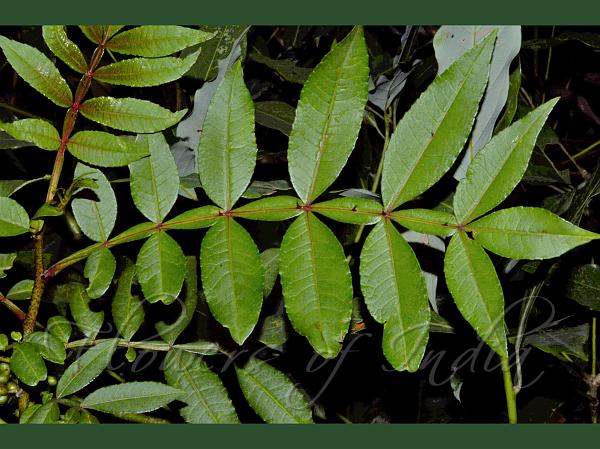|
| Andaliman Pepper |
|

|

| File size | 886611 |
| Original date | 5/16/18 3:09 PM |
| Resolution | 3008 x 2000 |
| Flash | Flash fired, return detected |
| Focal length | 60.0mm |
| Exposure time | 1/200s |
| Aperture | 29.0 |
| Focus Distance | |
| Metering Mode | Multi-segment |
| Camera make | NIKON CORPORATION |
| Camera model | NIKON D3200 |
| Sensor type | OneChipColorArea |
|
|
|
|
Photo: |
Botanical name: Zanthoxylum acanthopodium Family: Rutaceae (Citrus family)
Synonyms: Fagara acanthopodium, Zanthoxylum alatum, Zanthoxylum timbor
Synonyms: Fagara acanthopodium, Zanthoxylum alatum, Zanthoxylum timbor
Andaliman Pepper is a perennial erect shrub with spiny
stem, 2.5-3.0 m tall, with branches brown woolly. Leaves are
odd-pinnate, 10-30 cm long, leaflets ovate, lanceshaped to oblong,
pointed, margin sawtoothed; wings 0.8-1.2 cm broad between leaflets.
Flowers are borne in umbel-like panicles. Male flowers have
sepal-cup-lobed, petals 4, ovate-elliptic, stamens 4. Female flowers
have sepal-cup and flower as in male flowers; carpels 4, ovoid, styles
cohering. Ovary 2-5, carpellate. Fruit is a berry, ovoid and glandular.
Much like the closely related Sichuan pepper, the seed pericarps are
used as spices in cooking and have a similar tongue-numbing
characteristic. Andaliman Pepper is native to East Himalaya to S China
and W Malesia, at altitudes of 1600-2800 m. Flowering: April-May.
Medicinal uses: Mature fruits are eaten in
case of gastritis, stomach colic and liver complain, fruits are used as
anti typhoid, gastritis, liver disorder and toothache. The bark and
seeds are used as a tonic in fever and bowel complaints. It is supposed
to possess stomachia and carminative properties. In the ayurvedic
medicine, the bark, fruits and seeds are extensively employed as
carminative, stomachic and anthelmintic. The fruits are used for gums
and dental disorders as dyspepsia and lotion for scabies. Fresh roots
are used to cure dental problem.
Mature fruits are eaten in
case of gastritis, stomach colic and liver complain, fruits are used as
anti typhoid, gastritis, liver disorder and toothache. The bark and
seeds are used as a tonic in fever and bowel complaints. It is supposed
to possess stomachia and carminative properties. In the ayurvedic
medicine, the bark, fruits and seeds are extensively employed as
carminative, stomachic and anthelmintic. The fruits are used for gums
and dental disorders as dyspepsia and lotion for scabies. Fresh roots
are used to cure dental problem.
Medicinal uses:
 Mature fruits are eaten in
case of gastritis, stomach colic and liver complain, fruits are used as
anti typhoid, gastritis, liver disorder and toothache. The bark and
seeds are used as a tonic in fever and bowel complaints. It is supposed
to possess stomachia and carminative properties. In the ayurvedic
medicine, the bark, fruits and seeds are extensively employed as
carminative, stomachic and anthelmintic. The fruits are used for gums
and dental disorders as dyspepsia and lotion for scabies. Fresh roots
are used to cure dental problem.
Mature fruits are eaten in
case of gastritis, stomach colic and liver complain, fruits are used as
anti typhoid, gastritis, liver disorder and toothache. The bark and
seeds are used as a tonic in fever and bowel complaints. It is supposed
to possess stomachia and carminative properties. In the ayurvedic
medicine, the bark, fruits and seeds are extensively employed as
carminative, stomachic and anthelmintic. The fruits are used for gums
and dental disorders as dyspepsia and lotion for scabies. Fresh roots
are used to cure dental problem. | Identification credit: J.M. Garg | Photographed in Sakiyong Khasmahal, Pedong Reshi Rd. |
• Is this flower misidentified? If yes,